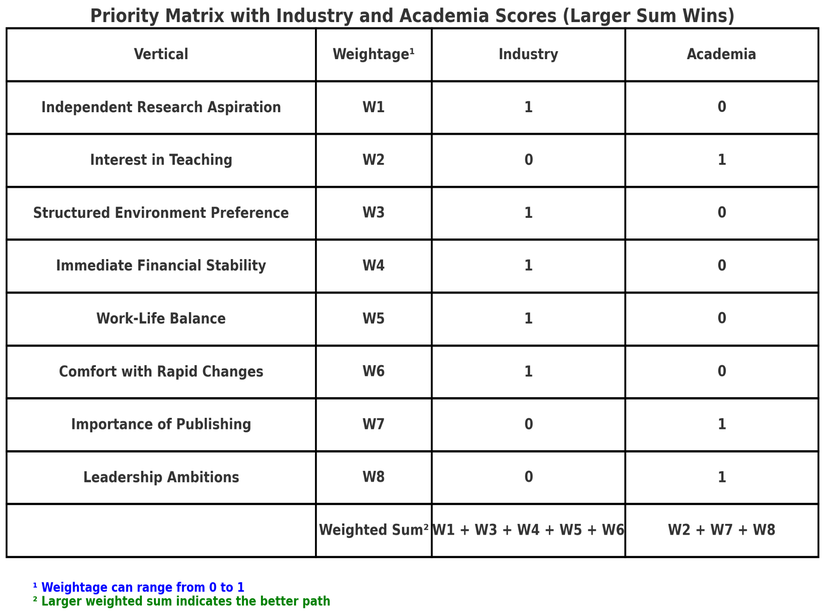The Pros and Cons of Academia vs. Industry Careers
For many graduates, the decision between academia and industry is more than just a career choice—it’s a decision that can shape your future. Both paths come with unique challenges and rewards, so how do you figure out which one is right for you?
Is academia calling your name, or do you see yourself thriving in an industry product development team? It’s a tough call, and there’s no one-size-fits-all answer. During my Ph.D. at Oregon State University, I often discussed this topic with a colleague. We put together a decision tree and a matrix to help lay out the pros and cons of each path, making the decision process easier to navigate. In this article, you’ll find an example of that decision matrix. From our discussions, here are some key factors to keep in mind when choosing your path.
Time Commitment: How Much Are You Willing to Invest?
One of the first things to think about is how much time you’re ready to commit to your career. Are you willing to put in the hours? A 2014 study by the Chronicle of Higher Education found that professors work an average of 61 hours a week, and those on the tenure track often work even more.
From my own experience, I can say that academia demands significant time. During my Ph.D., I’d sometimes get home from the lab at 1:30 a.m., only to hop on a Zoom call with my advisor at 2:30 a.m. This level of dedication is common in academic life.
In the end, the decision between academia and industry may come down to how much time you’re willing—and able—to invest. Both paths require effort, but academia can demand longer, less predictable hours, especially when you’re early in your career and trying to build your reputation.
Balancing Life and Work
This leads to an important point: balance. Bryan Dyson’s famous “Five Balls Theory,” shared during a Stanford commencement speech, offers a great perspective.

Dyson likens life to a game where you juggle five balls: work, family, health, friends, and spirit. Work is a rubber ball—drop it, and it bounces back. But the others—family, health, friends, and spirit—are glass. If you drop one, it could be marked, cracked, or shattered, and it may never be the same.
This is a powerful reminder that balance is key, but it’s also deeply personal. Some, like Einstein, devoted their lives to research with rigorous schedules. Others spread their time more evenly across life’s various aspects. Personally, my approach to balance has been shaped by my focus on fitness and other personal goals. It’s crucial to consider how your priorities will evolve over time.
What Motivates You?
What really excites you? Are you drawn to unraveling complex theories, or do you get more satisfaction from seeing your work applied in real-world products?
If deep, abstract thinking fires you up, academia might be your path. But if you enjoy applying theoretical knowledge to practical, real-world problems like time, safety, and cost constraints, industry could be a better fit.
Academic Flexibility
One major perk of academia is the freedom to choose what problems you want to work on. Many professors shift focus as their research evolves. For instance, some RF/Analog IC design professors are now incorporating AI and machine learning into their research. This flexibility allows academics to take on long-term, challenging projects where failure is just part of the learning process.
Industry’s Pragmatism
Industry, however, tends to focus on practicality and measurable results. Companies like Samsung, for instance, must release products annually to stay competitive. While some industry teams do publish research, it’s far less common than in academia, where publication is a core part of career advancement.
In industry, your project choices are usually aligned with company goals. You might spend years working on incremental improvements in the same field. However, seeing your work reach the masses and improve lives can be incredibly rewarding.
Personality Fit: Academia vs. Industry
Your personality plays a significant role in which path is right for you.
In academia, you’ll wear many hats—writing proposals, securing funding, teaching, publishing, and mentoring students. Strong communication and relationship management skills are essential for balancing these responsibilities.
In contrast, industry roles tend to be more specialized. For example, if you’re a manager, you may focus more on technical work or people management, depending on your strengths. This can lead to clearer job boundaries and less stress compared to academia.
Money Matters: Academia vs. Industry
The financial side is also worth considering. Assistant professors in the U.S. earn salaries similar to fresh Ph.D. graduates entering industry, but industry roles often come with bonuses, stock options, and benefits. On the flip side, academics can supplement their income through consulting and publishing.

In industry, there’s generally more financial stability due to the larger job market and competition for talent. Academic salaries, however, are often tied to securing external funding, which can add instability—especially in the early tenure-track years.
Entrepreneurial Opportunities
Some professors have leveraged their research to launch successful startups. A great example is Prof. Harish Krishnaswamy of Columbia University, whose company, MixComm Inc., was acquired for $155 million just four years after its founding. This shows that academic innovation can lead to lucrative entrepreneurial opportunities beyond traditional career paths.
Opportunities Beyond Traditional Industry and Academia
Deciding what to do after your Ph.D. or Masters can feel overwhelming, but there are some exciting alternatives beyond just academia or industry.
If you have an entrepreneurial spirit, starting a business based on your research could be incredibly rewarding. You’ll not only have the chance to see your innovative ideas come to life as real-world products, but there’s also potential for significant financial success.
National research labs are another option. These labs provide stable funding and resources to dive deep into cutting-edge research while collaborating with top scientists. It’s an ideal mix of applied and theoretical work that can be really fulfilling.
If you’re leaning toward industry but still want to focus on research, joining a research team could be a great fit. These teams often work on medium-term projects that directly influence product development, and you’ll have more flexibility in choosing your projects compared to traditional product development roles. Plus, working in interdisciplinary teams keeps things dynamic.
Academia vs. Industry Decision Matrix
Deciding between a career in academia or industry can feel overwhelming, but this example Priority Matrix is here to help break it down. Each row highlights a key factor to think about, with a weight (W1 to W8) showing how important that factor is to an individual. The matrix also scores whether academia or industry is the stronger option for each factor, using 0s and 1s.
At the bottom, you’ll find the weighted sum, which adds up the scores for both academia and industry. The idea is simple: the higher the sum, the better that option aligns with your goals.

Quick Notes: ¹ Weightage can go from 0 to 1, showing how significant each factor is to you and is highly personal. ² The larger weighted sum points to the better path.
So, what’s this really good for? It helps you visualize what matters most—whether it’s financial stability, independent research, teaching opportunities, or work-life balance—and see how each career path stacks up. This way, you can get a clearer picture of which direction might be the best fit for your future.
Conclusion: Academia or Industry?
There’s no definitive answer to which path—academia or industry—is better. It depends on your personal goals, the time you’re willing to commit, what motivates you, and how you fit within each environment. A helpful way to approach this decision is to create a flowchart or decision tree that outlines your options and visualizes the possible outcomes.
Remember, your decision isn’t set in stone. I know colleagues who’ve moved between academia and industry, illustrating the flexibility available to you. Take your time, reflect on your priorities, talk to mentors, explore internships, and allow yourself the space to make an informed decision.
Feel free to share your thoughts or questions in the comments—I’d be happy to discuss any aspect of this decision further!
Disclaimer: This blog post is for informational purposes only and does not constitute career advice. Please consult with a qualified career advisor before making any career decisions.



Pingback: How to Manage Financial Stress and Thrive in Grad School -
Pingback: How to Choose the Perfect Academic Advisor: A Comprehensive Guide